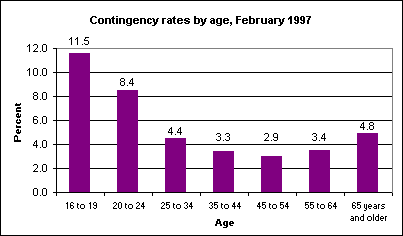An official website of the United States government
 United States Department of Labor
United States Department of Labor
In February 1997, about 5.6 million workers or 4.4 percent of those employed had contingent jobs—that is, jobs structured to be short term or temporary. Both the number and proportion of workers in such jobs were slightly lower than the figures reported two years ago. Young workers continued to be the most likely to work in contingent jobs.

[Chart data—TXT]
In 1997, nearly 700,000 teens aged 16 to 19 and nearly 1 million young people aged 20 to 24 had contingent jobs. The contingency rate for teens was 11.5 percent, and the rate for 20- to 24-year-olds was 8.4 percent.
Young contingent workers were more likely to be students than were their noncontingent counterparts. Among 16- to 24-year-olds, 64 percent of contingent workers were enrolled in school in 1997, compared with 40 percent of noncontingent workers. This suggests that the lack of long-term commitment associated with contingent work is often compatible with school attendance.
These data are produced by a supplement to the Current Population Survey. More information can be found in "Contingent work: results from the second survey,"Monthly Labor Review, November 1998. A summary of CPS data on such employment arrangements is available from news release USDL 97-422, "Contingent and Alternative Employment Arrangements, February 1997." Contingent workers are defined as individuals who do not perceive themselves as having an explicit or implicit contract with their employers for ongoing employment. The data on contingent workers in this story uses the broadest of three BLS definitions for such workers.
Bureau of Labor Statistics, U.S. Department of Labor, The Economics Daily, The young are most likely to be contingent workers at https://www.bls.gov/opub/ted/1999/feb/wk2/art02.htm (visited December 30, 2025).

